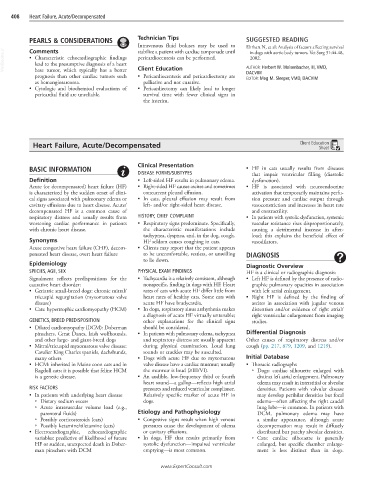Page 849 - Cote clinical veterinary advisor dogs and cats 4th
P. 849
408 Heart Failure, Acute/Decompensated
PEARLS & CONSIDERATIONS Technician Tips SUGGESTED READING
Intravenous fluid boluses may be used to Ehrhart N, et al: Analysis of factors affecting survival
Comments
VetBooks.ir • Characteristic echocardiographic findings pericardiocentesis can be performed. AUTHOR: Herbert W. Maisenbacher, III, VMD,
stabilize a patient with cardiac tamponade until
in dogs with aortic body tumors. Vet Surg 31:44-48,
2002.
lead to the presumptive diagnosis of a heart
Client Education
base tumor, which typically has a better
prognosis than other cardiac tumors such • Pericardiocentesis and pericardiectomy are DACVIM
EDITOR: Meg M. Sleeper, VMD, DACVIM
as hemangiosarcoma. palliative and not curative.
• Cytologic and biochemical evaluations of • Pericardiectomy can likely lead to longer
pericardial fluid are unreliable. survival time with fewer clinical signs in
the interim.
Heart Failure, Acute/Decompensated Client Education
Sheet
Clinical Presentation
BASIC INFORMATION • HF in cats usually results from diseases
DISEASE FORMS/SUBTYPES that impair ventricular filling (diastolic
Definition • Left-sided HF results in pulmonary edema. dysfunction).
Acute (or decompensated) heart failure (HF) • Right-sided HF causes ascites and sometimes • HF is associated with neuroendocrine
is characterized by the sudden onset of clini- concurrent pleural effusion. activation that temporarily maintains perfu-
cal signs associated with pulmonary edema or • In cats, pleural effusion may result from sion pressure and cardiac output through
cavitary effusions due to heart disease. Acute/ left- and/or right-sided heart disease. vasoconstriction and increases in heart rate
decompensated HF is a common cause of and contractility.
respiratory distress and usually results from HISTORY, CHIEF COMPLAINT • In patients with systolic dysfunction, systemic
worsening cardiac performance in patients • Respiratory signs predominate. Specifically, vascular resistance rises disproportionately,
with chronic heart disease. the characteristic manifestations include causing a detrimental increase in after-
tachypnea, dyspnea, and, in the dog, cough. load; this explains the beneficial effect of
Synonyms HF seldom causes coughing in cats. vasodilators.
Acute congestive heart failure (CHF), decom- • Clients may report that the patient appears
pensated heart disease, overt heart failure to be uncomfortable, restless, or unwilling DIAGNOSIS
to lie down.
Epidemiology Diagnostic Overview
SPECIES, AGE, SEX PHYSICAL EXAM FINDINGS HF is a clinical or radiographic diagnosis:
Signalment reflects predispositions for the • Tachycardia is a relatively consistent, although • Left HF is defined by the presence of radio-
causative heart disorder: nonspecific, finding in dogs with HF. Heart graphic pulmonary opacities in association
• Geriatric small-breed dogs: chronic mitral/ rates of cats with acute HF differ little from with left atrial enlargement.
tricuspid regurgitation (myxomatous valve heart rates of healthy cats. Some cats with • Right HF is defined by the finding of
disease) acute HF have bradycardia. ascites in association with jugular venous
• Cats: hypertrophic cardiomyopathy (HCM) • In dogs, respiratory sinus arrhythmia makes distention and/or evidence of right atrial/
a diagnosis of acute HF virtually untenable; right ventricular enlargement from imaging
GENETICS, BREED PREDISPOSITION other explanations for the clinical signs studies.
• Dilated cardiomyopathy (DCM): Doberman should be considered.
pinschers, Great Danes, Irish wolfhounds, • In patients with pulmonary edema, tachypnea Differential Diagnosis
and other large- and giant-breed dogs and respiratory distress are usually apparent Other causes of respiratory distress and/or
• Mitral/tricuspid myxomatous valve disease: during physical examination. Loud lung cough (pp. 217, 879, 1209, and 1219).
Cavalier King Charles spaniels, dachshunds, sounds or crackles may be ausculted.
many others • Dogs with acute HF due to myxomatous Initial Database
• HCM: inherited in Maine coon cats and in valve disease have a cardiac murmur; usually • Thoracic radiographs
Ragdoll cats; it is possible that feline HCM the murmur is loud (≥III/VI). ○ Dogs: cardiac silhouette enlarged with
is a genetic disease. • An audible, low-frequency third or fourth distinct left atrial enlargement. Pulmonary
heart sound—a gallop—reflects high atrial edema may result in interstitial or alveolar
RISK FACTORS pressures and reduced ventricular compliance. densities. Patients with valvular disease
• In patients with underlying heart disease Relatively specific marker of acute HF in may develop perihilar densities but focal
○ Dietary sodium excess dogs. edema—often affecting the right caudal
○ Acute intravascular volume load (e.g., lung lobe—is common. In patients with
parenteral fluids) Etiology and Pathophysiology DCM, pulmonary edema may have
○ Possibly corticosteroids (cats) • Congestive signs result when high venous a similar appearance, although acute
○ Possibly ketamine/tiletamine (cats) pressures cause the development of edema decompensation may result in diffusely
• Electrocardiographic, echocardiographic or cavitary effusions. distributed but patchy alveolar densities.
variables: predictive of likelihood of future • In dogs, HF that results primarily from ○ Cats: cardiac silhouette is generally
HF or sudden, unexpected death in Dober- systolic dysfunction—impaired ventricular enlarged, but specific chamber enlarge-
man pinschers with DCM emptying—is most common. ment is less distinct than in dogs.
www.ExpertConsult.com

